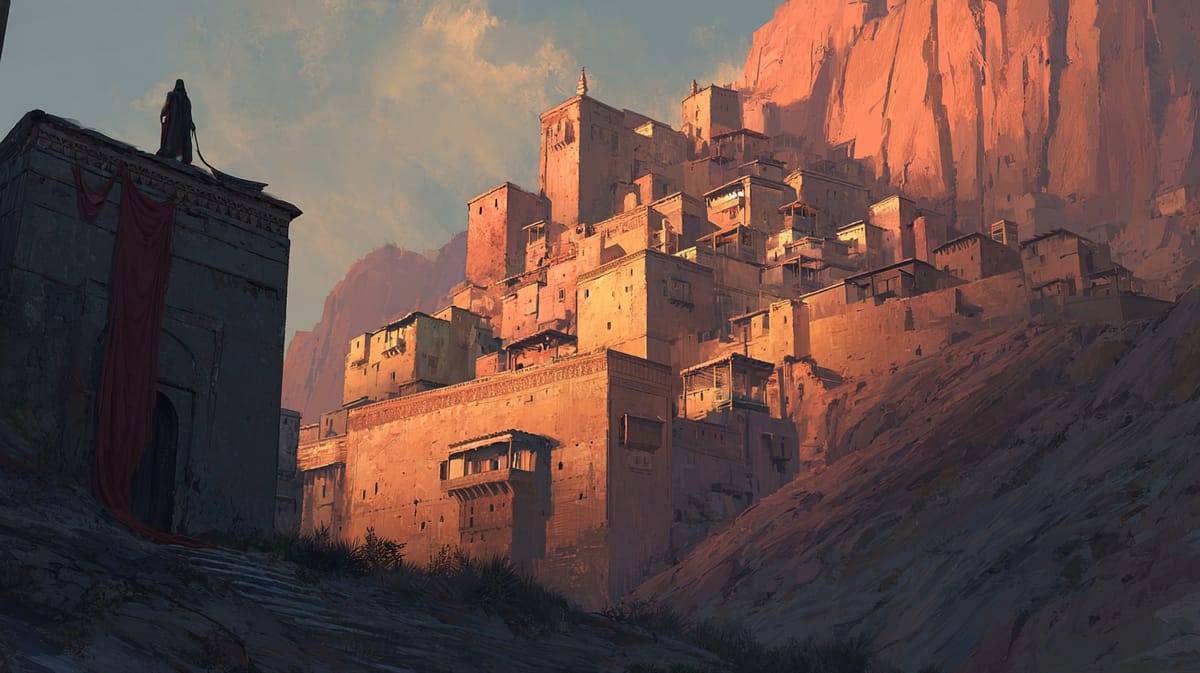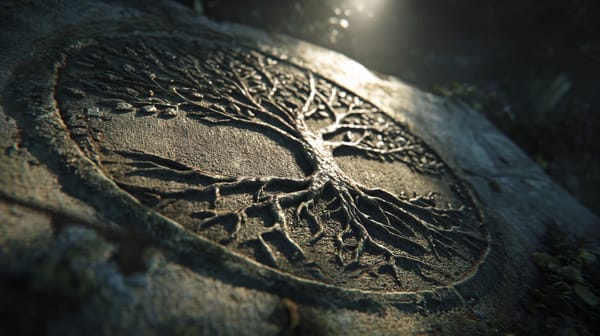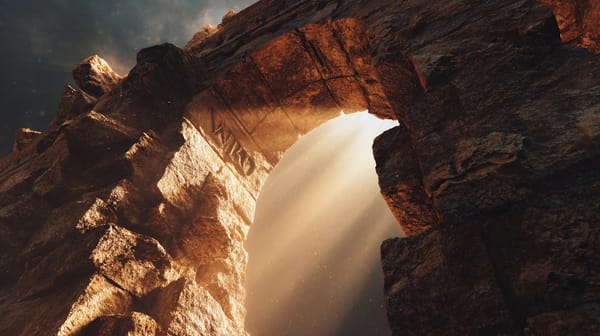Fairhaven Sermon 8-24-2025

Summary
In this week’s service, Rev. Peg Bowman explored the story of Joshua and the Battle of Jericho, placing it within its historical and archaeological context. She explained the significance of Jericho's location as a "tell" – a flattened hilltop offering strategic advantages – and discussed the varying interpretations of the biblical account presented by archaeologists. While acknowledging differing opinions on the historicity of the story, Rev. Bowman ultimately reaffirmed her belief in its truthfulness, emphasizing that the narrative serves as a powerful illustration of faith, obedience, and God’s judgment on idolatry.
Bowman highlighted key takeaways from the story, including the importance of prioritizing God above all else, trusting in God's plan even when it seems impossible, and embracing unity within the faith community. She drew a poignant parallel to the film "Joan of Arc" to convey the tragic, often violent reality of victory, ultimately underscoring God's ability to preserve goodness even within corrupted environments, noting Rahab’s lineage to King David and ultimately, Jesus.
Transcript
We're in place. Okay, well, good morning. This morning we're continuing our sermon series on Bible stories we learned as children. And today's story is Joshua and the Battle of Jericho, which you just heard.
And like so many Old Testament stories, the events described in Joshua chapter 6 happened a long time ago. So we're going to need to have some background on this. If I could have slide two, please. There we go.
First off, I wanted to show where exactly we're talking about. This is a modern day map showing...
The lighter brown area, this and this, that's Palestinian territory right now. And the dark orange area is Israel. This would have been sort of all differently owned, shall we say, or differently managed back in those days. But you can see Jerusalem is here, and Jericho is almost due east of it.
And there's Bethlehem, so it's sort of northeast of Bethlehem. So that's kind of where we are. And the people of Israel had approached this, coming up around this side and into Jericho. So that's where we are.
Also wanted to point out one other thing on here, and that's Tel Aviv up here. That's where the international airport is now. But I wanted to point out the name of that place, Tel Aviv. I know you all have heard of that.
But the word tell is kind of like the word mountain, Mount Washington. Okay. A tell is not a mountain, but a tell is what I guess started out as a mountain, but somehow the top got flattened. And so a tell is a mountain with a flat top, which is.
.. Really, really helpful, especially back in those days, how handy that would have been because people could live on top of the tell, they could build on there, and it would be really easy to defend. So Tel Aviv, great place to put an airport, isn't it, on top of a flattened hill.
Same thing, same basic idea. The biblical city of Jericho, slide three if you would please. There we go. I'll talk about that in a moment.
The biblical city of Jericho today is called Tel Es Sultan. So Jericho itself is also a Tel. You can see that this mountain is essentially flat on top. Now this particular picture, this is modern day photo of where this location is, but I notice this north is downwards, okay? This is basically upside down, but when I tried turning it right side up, all these crevices, you could hardly see them, which is kind of a weird little something that kind of fakes your eyes out.
But anyway, these crevices are where archeological digs have been right along in here. So you can see that, okay, we have this, it's essentially a flattened top, Mounted on all sides. We have a modern day road here, modern day roads all the way around. Of course, those roads were not there, I think, except for sort of a footpath on this side, on either side at the time.
This Helltop was also back in biblical days, was well fed by streams and underground water. There's all kinds of water around here, so they had no problems getting water up the hill. Very nice place to live, right? That's biblical Jericho. And this also, this Jericho had two walls, not one, but two walls around it.
And if I get the next slide up, there we go. This is right side up now, okay. And so we have an upper wall right here. And the inside of this, like I said, was essentially flat.
That's where the houses would be. That's where the farmland would be. All of any cattle or sheep or whatever would all be living up inside this upper wall. And then the outer wall was there for protection.
So the upper wall basically just as a way of setting aside people's properties and the lower wall for protection. And then there's this sort of this pinkish area in between, which would have been very steep and, People went in there, but not for very long and not for very often. What would you do with some steep, rocky material? So that's where we were. You can see again, this is where the modern day road is now.
And also this is where the reservoir is right now. Okay, that's one of the water supplies that was there for the city. So that tells you a little bit about Jericho, just what it looked like, what it was like back then. So the walls were there to defend both the city and to protect the food and water supply.
And up to this point, everything I have said is basically common knowledge and can be found in any history, encyclopedia, archaeological record, any of that kind of stuff. But as with many ancient stories, both biblical and otherwise, archaeological studies raise some questions and the archaeological digs at Jericho are no exception. So I wanted to share some of what modern day historians and archaeologists have to say. When we look at the historical record, it is clear that there have been people living here for a long time.
In fact, there was more than one civilization here. According to Wikipedia, Jericho is one of the oldest cities in human history. There's evidence of people having lived on this tell as far back as 10,000 BC. There were people there throughout the Neolithic era, which goes up to 6500 BC.
They have found artifacts from the Bronze Age and the Iron Age. And because of all this history, different archaeologists find different things when they go digging. They find things from different eras, from different time periods, and from different cultures. And for this reason, some archaeologists think the story of Joshua is a myth, and others think the story is entirely possible.
It depends on what you hit when you dig. And as one archeologist I read put it, when you start digging, whatever you want to believe is probably what you will find. So, which is true of so much of life, but at any rate, in this case, after having looked over the evidence myself, I don't see any reason why the biblical story would not be true. There is no disproof in any of the arguments or in any of the history.
So having said all of this, let's turn now to the Bible and hear God's word. We'll keep that up for a little bit for reference purposes there. So back in Joshua chapter 2, before the reading that we heard today, As the people of Israel were traveling from Egypt in the south up into the Promised Land, Joshua sent spies ahead of the people and told them to look around and see what was on the road ahead. And Joshua said to them, Pay special attention to Jericho.
When the spies came to Jericho, they entered the house of a prostitute named Rahab. They probably did this so that anybody who saw them coming in would think they were there for a good time and wouldn't think twice about it. But this didn't work. They were noticed.
And Rahab was questioned by the authorities, and when they came to search her house, she hid the spies up on the roof under some flax that she was processing, and she told the authorities, Yes, they were here, but when they left the city, when the city gates closed for the night, if you're fast enough, you might catch up to them. So they left in search of the spies. And then Rahab said to the spies, I know the Lord has given you this land. Everyone here is afraid of you.
We've heard about how God dried up the Red Sea so that you could walk through it. The Lord your God really is God. So since I have dealt kindly with you, swear to me that you will deal kindly with me and my family. And the men answered her, Yes, our lives for yours.
So Rahab helped them to escape, by letting them down through a window in her house because her house was built into the city wall. All right, the estimates for people who've dug around, they say that she probably lives somewhere around down here, which makes sense because you would have been able to kind of get out into the countryside very quickly from that spot. So, the men gave her a crimson rope to tie in her window to let the Israeli soldiers know where she was and told her to gather all of her family together in her house for safety. And a few days later, maybe a week later, Joshua and the Israelites arrived at the walls of Jericho.
Joshua says, The city of Jericho was shut up inside and out. The people were afraid, and the gates and the walls were closed, locked, and guarded, and no one was going in or out. Meanwhile, God gave Joshua a game plan, one that relied on the faith of God's people. For this plan to succeed, the whole nation of Israel had to trust God and do as God said to do.
God said, Jericho is yours for the taking. Here's what you need to do: get your warriors together, get your priests together, get the Ark of the Covenant which held the Ten Commandments and some of the manna from their journey, put the Ark in the middle of the priests, put the priests blowing trumpets around the Ark, put the soldiers around the priests, and have the people follow. and march around the city one time today and one time tomorrow. Not saying a word, not saying a word, blowing the trumpets, but not saying a word.
And this would have taken, they estimate, it would have taken a little bit more than an hour to walk around the city. So that's what they were doing once a day. Now the city of Jericho was not heavily populated. The scholars estimate there were between 1,500 to 2,000 people in this city.
So imagine what the people at the top of the hill were thinking as they saw this army with trumpets marching around the city. and all the people following in silence. And they saw the Ark of the Covenant, which was obviously a religious thing. They didn't know exactly what it was, but it had angels on the lid.
They knew it was surrounded by priests. So they knew that both God and soldiers were marching around the city. And this went on every day for six days. Now, one of the things the Bible doesn't tell us, and a lot of the history books lead this out too, is that Jericho sat, and still does sit by the way, on a fault line, kind of like California.
And because of this, there were a lot of earthquakes in the area. Now, is it possible that all that marching and trumpet blowing shook some things loose? We don't know. We can't prove that one way or the other. But speaking as a musician, I know what sound can do.
I expect it had an effect. And then on the seventh day, the army of Israel and the priests and the Ark marched around the city seven times. Seven being the number of completion or perfection. just like the world had been made in seven days.
And God told the people after the seventh time, shout a mighty shout and then go straight up the hill and devote the entire city to God. Now, the phrase devote the city to God was a euphemism for kill everyone and burn the city to the ground. Leave nothing behind. This is a horrific order.
And it's an order that God rarely gave. And whenever the order was given, it was always and only about cities or regions where the people were so corrupted by idolatry, And it's an order that God rarely gave. so taken by the worship of lies, so wrapped up in evil that they needed to be removed from the land. There was no other solution.
Think about this. I mean, the only person that God chose to save out of all the people in Jericho was the city's lady of the evening. So she was the best of them. Right? So we talk about day seven.
Let me, before we talk about that, can we move to the next slide, please? Okay, this is a side view of what the walls would have looked like. Now this one's a little bit inaccurate 'cause this should be flat on this side. This would have been the top of the tail. But that's the upper wall.
People would be living over here. This is the lower wall. When the walls fell, and the archaeological evidence bears this out, the upper one crumbled and sort of rolled down the hill. The lower one, however, fell, as it says in Scripture, flat.
Right? In the whole piece. So the kind of attack that they were doing was what was called a siege. I've talked about a siege before and usually what they would do in a siege would be lock up all the city gates and basically starve the city to death, right? Okay? And while you're doing a siege, you would also be building a siege ramp up into this if you were attacking people, building a siege ramp up into the city so that you could get into it at the end and get all the stuff. In this case, they didn't have to build a siege ramp.
The siege ramp built itself. flat down. So it literally says in the scriptures, they went straight up from where they were standing, straight up the hill. The walls were gone.
So that's how that kind of worked out. What happened here really was a miracle. When the army stopped marching, and the trumpets blew, and the people shouted, the upper wall collapsed and crumbled, the bottom wall fell straight down, creating that ramp, and they walked in. At God's command, the army of Israel, captured all of the city's treasures of gold, silver, bronze, and iron, which were put into the Lord's treasury, and everyone else and everything else was destroyed, And except for Rahab and her family.
Everything else was burned to the ground, which explains why archaeologists have found jars full of burnt grain uneaten. in the houses. Because during a real siege, they would have run out of food. But these people didn't run out of food.
There's evidence of massive food everywhere that was burnt. Tells us exactly this is what happened. And on top of this, Joshua cursed the city and said that anyone who rebuilt it would do so at the cost of their children's lives. He said, Cursed before the Lord be the man who rises up and rebuilds this city, Jericho.
At the cost of his firstborn shall he lay its foundation, and at the cost of his youngest son shall he set up its gates. So this hill stood empty for hundreds of years. People knew the curse. They left it alone.
But much later, during the reign of King Ahab, who was known for not listening to God, a man from Bethel rebuilt Jericho. His oldest son died during the laying of the foundation, and his youngest son died when they put up the city gates, just like Joshua had said. So that's how the land on which Jericho once stood became part of the nation of Israel. And Jericho, what was left of it, was given to the tribe of Benjamin.
And, There is a newer city named Jericho, which is built near the ruins, but it's not actually up on the tell. That tell is still empty, as you saw that very first picture, or the picture of the archaeology, that's what it looks like today. It's just a dirt with a bunch of holes in it, that's it. So the story of Joshua and the Battle of Jericho is a story of great faith, and it's also tragic.
It's a story of a city that couldn't be saved or wouldn't be saved. Its people were so wicked that God had to wipe them out, and Israel obeyed God when he told them to do so. When I read stories like this, They remind me of a movie I saw as a kid. Some of you might remember this maybe.
Remember Joan of Arc? The original one starring Angry Birdman. It goes back, it's an old 1940s black and white movie. Some of you are going, I don't think so. Anyway, great movie, it's a wonderful movie.
But Joan's courage has always inspired me. But in this movie, when she leads the French to their first victory, as a leader of their army. The soldiers are celebrating, but Joan is found on the battlefield weeping. And one of the soldiers asks her why, and she answers, I thought victory would be beautiful, but it is an ugly, bloody thing.
That's how it was in Jericho. It's a sad story. It's a bloody thing. The city, having been destroyed, plundered, and burned to the ground, was not resettled.
The ruins were left as a warning to passersby. It had been a place of great evil, and the evil had to end. The people of Israel, after this battle, moved on. They crossed the Jordan River and then into Jerusalem.
Their future was just starting. And as for Rahab, God never forsakes his own. Rahab was faithful to God, and we remember her words. She said, The Lord your God really is God.
And Rahab ended up marrying a man named Solomon, and they had a son named Boaz. And Boaz grew up and met and married Ruth, and they had a son named Obed, and Obed had a son named Jesse, and Jesse had a son named David. So Rahab was King David's great-great-grandmother. God saved the very best of Jericho, and that best still lives on in David and in Jesus.
So what can we take away from this story? I have six thoughts to share. Take them as you will. Number one, and most important, God will deal with idolatry. God takes idolatry very seriously.
Commandment number one says, you shall have no other gods but me. You shall not worship anything else or anyone else. This may be, there may be important people in our lives, important things in our lives, but God wants to be number one. above them all.
If there is anything or anyone that we love more than God, that's an idol, and we need to take it down off its pedestal. Our first loyalty needs to be to Jesus, both for our sake and for the sake of others. Number two, just like the city of Jericho and its walls, God knows where the weak spots are. We may not know how to attack a problem, but God does.
Who could have guessed that a week of marching and some trumpet blasts would bring down city walls? but God knew where the weak spots were, and God still does today. So as we bring our prayers and our concerns to God, allow God to get into the weak spots of life. Allow God to do some healing. I'm calling.
Number three, trust God and do what God commands. God will never steer God's people wrong, keep following even if the journey seems impossible, and especially when the journey seems impossible. Four, God's timing is always right. If Joshua had attacked the city too soon or too late, the results might have been different.
So trust God to know the right time. Number five, stay together. We are the family of God, and we need to move together like Israel did, in unity, not uniformity, but in unity. We are not all the same, and God designed us to be different.
So our differences are healthy, but we need to move together as the family of God. And last, finally, the way that God dealt with the people of Jericho is a rare exception. We should never assume that God wants to wipe out certain people groups. Almost always, we should welcome strangers, share with others, and communicate what we believe.
Violence should be avoided unless God specifically commands it. So that's the story of Joshua and Jericho. May God bless it to our understanding and to our living. Amen.



